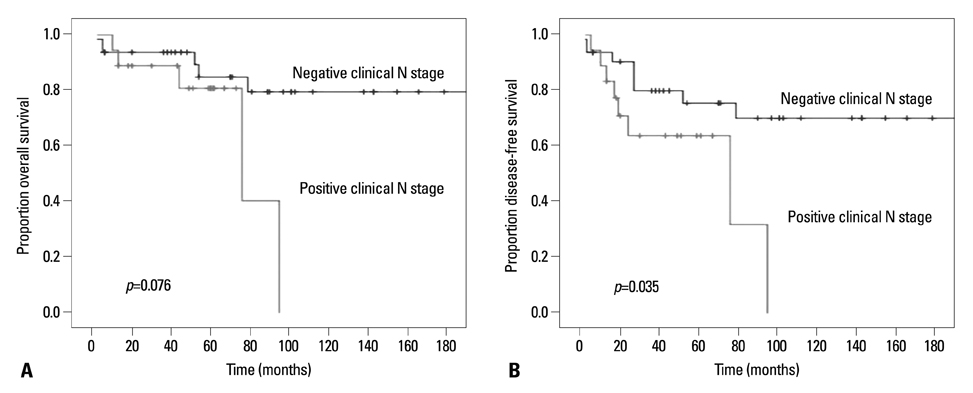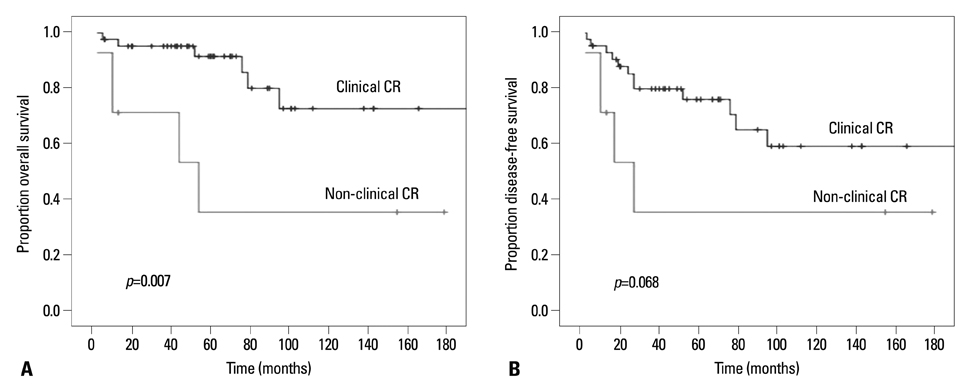Yonsei Med J.
2013 Jan;54(1):108-115. 10.3349/ymj.2013.54.1.108.
Long-Term Outcomes of Chemoradiation for Anal Cancer Patients
- Affiliations
-
- 1Department of Surgery, Chonnam National University Hwasun Hospital and Medical School, Jeollanam-do, Korea. jwhuh@hotmail.com
- 2Department of Radiation Oncology, Chonnam National University Hwasun Hospital and Medical School, Jeollanam-do, Korea.
- KMID: 1776925
- DOI: http://doi.org/10.3349/ymj.2013.54.1.108
Abstract
- PURPOSE
The aim of this study was to evaluate long-term oncologic outcomes after concurrent chemoradiation treatment for anal cancer.
MATERIALS AND METHODS
Between January 1979 and December 2008, the records of 50 consecutive patients with anal cancer and who were treated by chemoradiation or radiation only with a curative intent were retrospectively reviewed. The oncologic outcomes and the risk factors for recurrence were analyzed.
RESULTS
Of the 50 patients, 49 underwent concurrent chemoradiation and one underwent radiation only. After these definitive treatments, 43 (86.0%) achieved a clinical complete response. During the median follow-up of 60 months (range: 2-202 months), the 5-year overall survival, disease-free survival, and locoregional recurrence-free survival were 84.2%, 72.7%, and 69.9%, respectively. Multivariate analysis revealed that the performance status (p=0.031) and a clinical complete response (p=0.039) were the independent predictors for overall survival; lymph node involvement (p=0.031) was the only independent predictor for disease-free survival.
CONCLUSION
The performance status and a clinical complete response may be reliable predictors of survival after chemoradiation for anal cancer. The addition of irradiation to the inguinal area may not be significantly associated with the outcomes.
Keyword
MeSH Terms
Figure
Reference
-
1. Northover J, Glynne-Jones R, Sebag-Montefiore D, James R, Meadows H, Wan S, et al. Chemoradiation for the treatment of epidermoid anal cancer: 13-year follow-up of the first randomised UKCCCR Anal Cancer Trial (ACT I). Br J Cancer. 2010. 102:1123–1128.
Article2. Ferrigno R, Nakamura RA, Dos Santos Novaes PE, Pellizzon AC, Maia MA, Fogarolli RC, et al. Radiochemotherapy in the conservative treatment of anal canal carcinoma: retrospective analysis of results and radiation dose effectiveness. Int J Radiat Oncol Biol Phys. 2005. 61:1136–1142.
Article3. Huang K, Haas-Kogan D, Weinberg V, Krieg R. Higher radiation dose with a shorter treatment duration improves outcome for locally advanced carcinoma of anal canal. World J Gastroenterol. 2007. 13:895–900.
Article4. Cantril ST, Green JP, Schall GL, Schaupp WC. Primary radiation therapy in the treatment of anal carcinoma. Int J Radiat Oncol Biol Phys. 1983. 9:1271–1278.
Article5. Conroy T, Ducreux M, Lemanski C, Francois E, Giovannini M, Cvitkovic F, et al. Treatment intensification by induction chemotherapy (ICT) and radiation dose escalation in locally advanced squamous cell anal canal carcinoma (LAAC): definitive analysis of the intergroup ACCORD 03 trial. J Clin Oncol. 2009. 27:15S. 4033.
Article6. Cummings BJ, Keane TJ, O'Sullivan B, Wong CS, Catton CN. Epidermoid anal cancer: treatment by radiation alone or by radiation and 5-fluorouracil with and without mitomycin C. Int J Radiat Oncol Biol Phys. 1991. 21:1115–1125.
Article7. Das P, Bhatia S, Eng C, Ajani JA, Skibber JM, Rodriguez-Bigas MA, et al. Predictors and patterns of recurrence after definitive chemoradiation for anal cancer. Int J Radiat Oncol Biol Phys. 2007. 68:794–800.
Article8. Gerard JP, Ayzac L, Hun D, Romestaing P, Coquard R, Ardiet JM, et al. Treatment of anal canal carcinoma with high dose radiation therapy and concomitant fluorouracil-cisplatinum. Long-term results in 95 patients. Radiother Oncol. 1998. 46:249–256.
Article9. Edge SB, Compton CC. The American Joint Committee on Cancer: the 7th edition of the AJCC cancer staging manual and the future of TNM. Ann Surg Oncol. 2010. 17:1471–1474.
Article10. Oken MM, Creech RH, Tormey DC, Horton J, Davis TE, McFadden ET, et al. Toxicity and response criteria of the Eastern Cooperative Oncology Group. Am J Clin Oncol. 1982. 5:649–655.
Article11. Cox JD, Stetz J, Pajak TF. Toxicity criteria of the Radiation Therapy Oncology Group (RTOG) and the European Organization for Research and Treatment of Cancer (EORTC). Int J Radiat Oncol Biol Phys. 1995. 31:1341–1346.
Article12. UKCCCR Anal Cancer Trial Working Party. UK Co-ordinating Committee on Cancer Research. Epidermoid anal cancer: results from the UKCCCR randomised trial of radiotherapy alone versus radiotherapy, 5-fluorouracil, and mitomycin. Lancet. 1996. 348:1049–1054.13. Bartelink H, Roelofsen F, Eschwege F, Rougier P, Bosset JF, Gonzalez DG, et al. Concomitant radiotherapy and chemotherapy is superior to radiotherapy alone in the treatment of locally advanced anal cancer: results of a phase III randomized trial of the European Organization for Research and Treatment of Cancer Radiotherapy and Gastrointestinal Cooperative Groups. J Clin Oncol. 1997. 15:2040–2049.
Article14. Cummings BJ. Anal cancer. Int J Radiat Oncol Biol Phys. 1990. 19:1309–1315.
Article15. Thomas CR Jr, Stelzer KJ, Douglas JG, Koh WJ, Wood LV, Panicker R. Common emergencies in cancer medicine: infectious and treatment-related syndromes, Part II. J Natl Med Assoc. 1994. 86:839–852.16. Ajani JA, Winter KA, Gunderson LL, Pedersen J, Benson AB 3rd, Thomas CR Jr, et al. Fluorouracil, mitomycin, and radiotherapy vs fluorouracil, cisplatin, and radiotherapy for carcinoma of the anal canal: a randomized controlled trial. JAMA. 2008. 299:1914–1921.
Article17. Martenson JA, Lipsitz SR, Lefkopoulou M, Engstrom PF, Dayal YY, Cobau CD, et al. An Eastern Cooperative Oncology Group study. Results of combined modality therapy for patients with anal cancer (E7283). Cancer. 1995. 76:1731–1736.
Article18. Veldeman L, Madani I, Hulstaert F, De Meerleer G, Mareel M, De Neve W. Evidence behind use of intensity-modulated radiotherapy: a systematic review of comparative clinical studies. Lancet Oncol. 2008. 9:367–375.
Article19. Salama JK, Mell LK, Schomas DA, Miller RC, Devisetty K, Jani AB, et al. Concurrent chemotherapy and intensity-modulated radiation therapy for anal canal cancer patients: a multicenter experience. J Clin Oncol. 2007. 25:4581–4586.
Article20. Milano MT, Jani AB, Farrey KJ, Rash C, Heimann R, Chmura SJ. Intensity-modulated radiation therapy (IMRT) in the treatment of anal cancer: toxicity and clinical outcome. Int J Radiat Oncol Biol Phys. 2005. 63:354–361.
Article21. Kachnic LA, Tsai HK, Coen JJ, Blaszkowsky LS, Hartshorn K, Kwak EL, et al. Dose-painted intensity-modulated radiation therapy for anal cancer: a multi-institutional report of acute toxicity and response to therapy. Int J Radiat Oncol Biol Phys. 2012. 82:153–158.
Article22. Vieillot S, Fenoglietto P, Lemanski C, Moscardo CL, Gourgou S, Dubois JB, et al. IMRT for locally advanced anal cancer: clinical experience of the Montpellier Cancer Center. Radiat Oncol. 2012. 7:45.
Article23. Ryan DP, Compton CC, Mayer RJ. Carcinoma of the anal canal. N Engl J Med. 2000. 342:792–800.
Article24. Ajani JA, Winter KA, Gunderson LL, Pedersen J, Benson AB 3rd, Thomas CR Jr, et al. Prognostic factors derived from a prospective database dictate clinical biology of anal cancer: the intergroup trial (RTOG 98-11). Cancer. 2010. 116:4007–4013.
Article25. Touboul E, Schlienger M, Buffat L, Lefkopoulos D, Pène F, Parc R, et al. Epidermoid carcinoma of the anal canal. Results of curative-intent radiation therapy in a series of 270 patients. Cancer. 1994. 73:1569–1579.
Article26. Deniaud-Alexandre E, Touboul E, Tiret E, Sezeur A, Houry S, Gallot D, et al. Results of definitive irradiation in a series of 305 epidermoid carcinomas of the anal canal. Int J Radiat Oncol Biol Phys. 2003. 56:1259–1273.
Article27. Schwarz JK, Siegel BA, Dehdashti F, Myerson RJ, Fleshman JW, Grigsby PW. Tumor response and survival predicted by post-therapy FDG-PET/CT in anal cancer. Int J Radiat Oncol Biol Phys. 2008. 71:180–186.
Article28. Jeong JU, Yoon MS, Song JY, Ahn SJ, Chung WK, Nah BS, et al. The results of curative concurrent chemoradiotherapy for anal carcinoma. J Korean Soc Ther Radiol Oncol. 2010. 28:205–210.
Article29. Chen YW, Yen SH, Chen SY, Huang PI, Shiau CY, Liu YM, et al. Anus-preservation treatment for anal cancer: retrospective analysis at a single institution. J Surg Oncol. 2007. 96:374–380.
Article
- Full Text Links
- Actions
-
Cited
- CITED
-
- Close
- Share
- Similar articles
-
- Clinicopathologic Characteristics of Anal Cancer
- Recent Advances in the Diagnosis and Treatment for Rectal Cancer
- Late Complications after Preoperative Chemoradiation for Rectal Cancers
- Survival and Operative Outcomes After Salvage Surgery for Recurrent or Persistent Anal Cancer
- The Prognosis of Anal Cancer According to the Modality of Therapy



